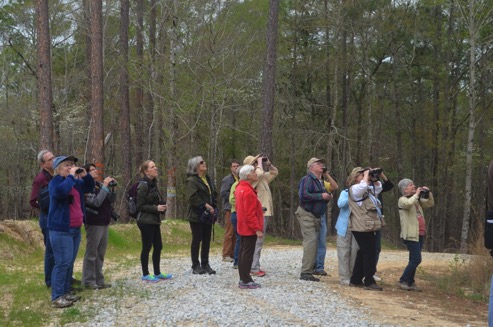YA Eco Mysteries, Memoirs, Novels & Travel
06 April 2014
Hiking The Tuskegee National Forest
06/04/14 10:53 Filed in: Environment
Audubon Field Trip to Tuskegee National Forest
On a crisp early morning in April, a group of intrepid explorers from the Birmingham Audubon Society arrive at the Pleasant Hill Trailhead in the Tuskegee National Forest. Bird calls ring out high above, which our knowledgable birders identify for the novices as pine warblers, red-eyed vireos, brown thrashers, eastern towhees, northern cardinal, Carolina wrens and a variety of other birds. The blackened areas in the forest show the on going effort by the US Forest Service to restore the longleaf pines by controlled burning of undergrowth.This is because extensive timbering and replanting with loblolly pine during the settlement period of the nineteenth century increased the population of pine beetle and caused a sharp decline in longleafs—and with them the endangered Red-cockaded woodpecker that nests in mature longleaf pine forests with grassy undergrowth.
 Read More...
Read More...
On a crisp early morning in April, a group of intrepid explorers from the Birmingham Audubon Society arrive at the Pleasant Hill Trailhead in the Tuskegee National Forest. Bird calls ring out high above, which our knowledgable birders identify for the novices as pine warblers, red-eyed vireos, brown thrashers, eastern towhees, northern cardinal, Carolina wrens and a variety of other birds. The blackened areas in the forest show the on going effort by the US Forest Service to restore the longleaf pines by controlled burning of undergrowth.This is because extensive timbering and replanting with loblolly pine during the settlement period of the nineteenth century increased the population of pine beetle and caused a sharp decline in longleafs—and with them the endangered Red-cockaded woodpecker that nests in mature longleaf pine forests with grassy undergrowth.
 Read More...
Read More...

